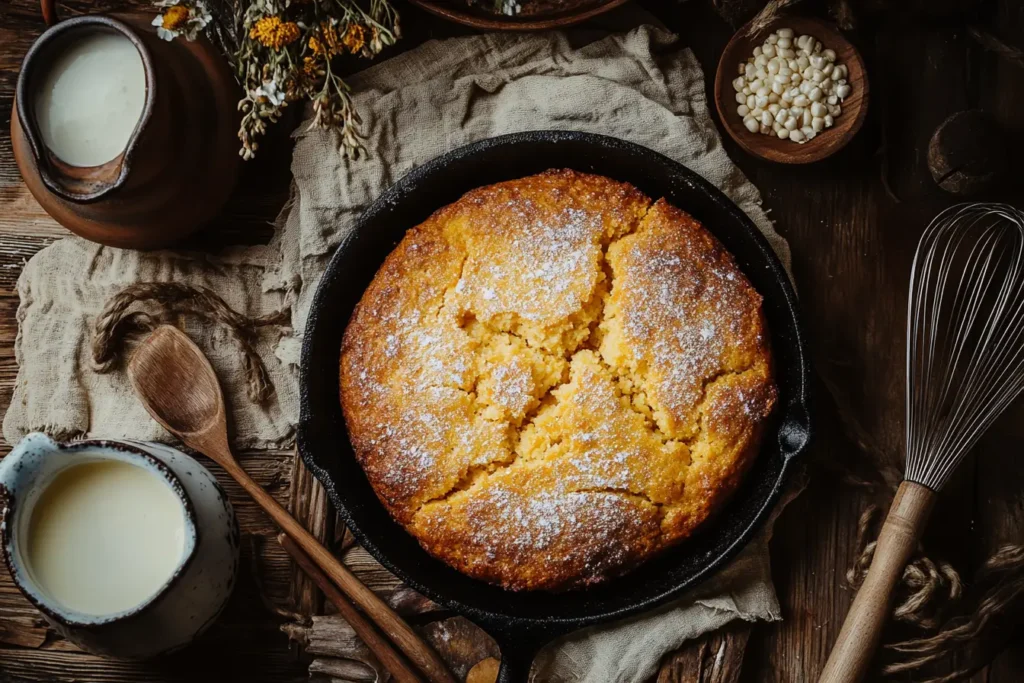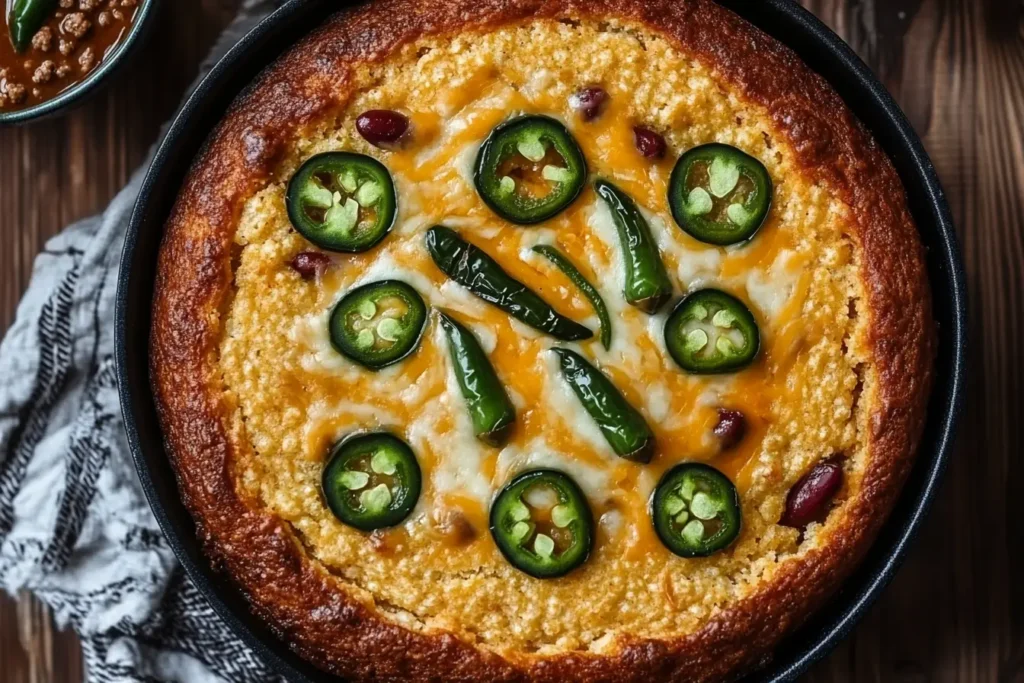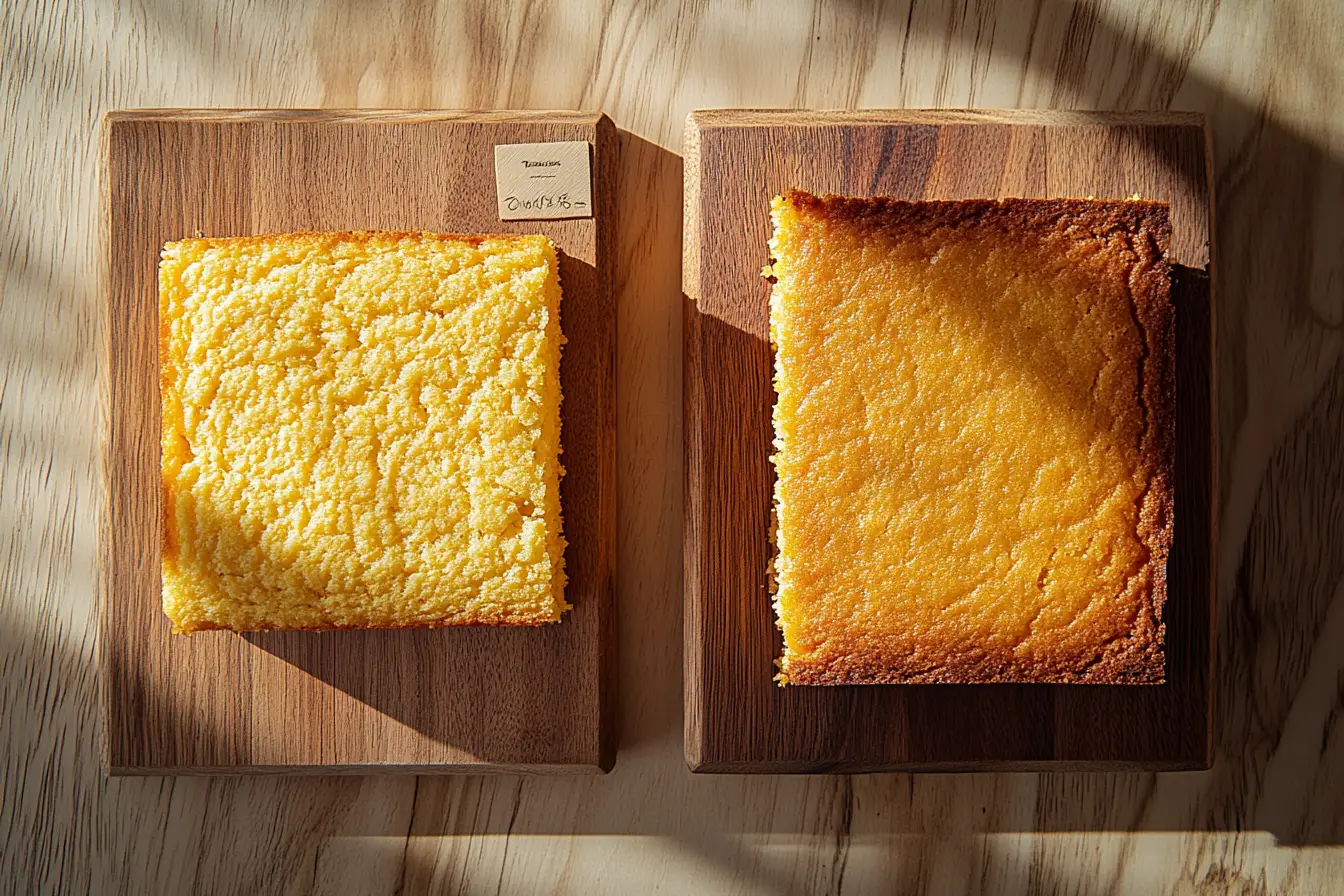Cornbread is a quintessential dish in American cuisine, beloved for its simplicity and versatility. However, not all cornbread is created equal. If you’ve ever wondered what is the difference between cornbread and Southern cornbread, this guide will walk you through the ingredients, preparation techniques, and cultural distinctions that set them apart. From sweet, fluffy versions to savory, skillet-baked creations, cornbread reflects the culinary traditions of the regions it comes from. Let’s dive into the delicious details!
Overview of Cornbread and Its Varieties
A Brief History of Cornbread in American Cuisine
Cornbread has deep roots in American history, originating with Native American cooking. Corn, a staple crop, was ground into meal and baked into simple cakes. European settlers quickly adopted these techniques, creating variations that suited local ingredients and tastes. Cornbread’s accessibility and affordability cemented its role as a staple in the American diet, especially during times of economic hardship.
Regional Influences on Cornbread Recipes
Over the years, cornbread evolved into different styles across the United States. In the North, cornbread often features sugar and a cake-like texture. Meanwhile, the South developed its own version, characterized by a savory profile and crispy crust. The ingredients and methods reflect regional preferences, available resources, and cultural influences, resulting in distinct variations of this humble bread.
How Southern Cornbread Became a Distinct Variant
Southern cornbread stands out for its simplicity and bold flavor. It prioritizes cornmeal as the star ingredient, avoiding sweeteners that might overshadow its natural taste. Cooking methods like using a preheated cast iron skillet give our dish its trademark crispy edges. This version became a Southern staple, embodying the region’s resourceful and flavor-driven approach to cooking.
Key Ingredients in Cornbread vs. Southern Cornbread
Traditional Cornbread Ingredients
Traditional cornbread recipes typically include a mix of cornmeal, flour, sugar, milk, and baking powder. These ingredients create a light, slightly sweet bread with a cake-like texture. Sugar is a hallmark of non-Southern cornbread, as it adds sweetness to the overall flavor. Most traditional recipes lean on white or yellow cornmeal, depending on regional availability, and butter or vegetable oil is used to add moisture and richness.
| Nutrient | Amount (Per 100g) |
|---|---|
| Calories | 190 kcal |
| Protein | 4 g |
| Carbohydrates | 28 g |
| Sugar | 2 g |
| Fat | 6 g |
| Saturated Fat | 1 g |
| Fiber | 2 g |
| Cholesterol | 15 mg |
| Sodium | 400 mg |
| Calcium | 30 mg |
| Iron | 1 mg |
What Makes Southern Cornbread Unique?
The southern twist takes a different approach, opting for a savory, less sweet flavor. The key distinction lies in the absence of sugar and a stronger emphasis on the natural taste of the cornmeal. Southern recipes often include buttermilk instead of regular milk, which adds a subtle tanginess and helps create a denser, heartier bread. Additionally, Southern cornbread relies heavily on cast iron skillets, which produce its iconic crispy crust.
The Role of Cornmeal Types: White vs. Yellow Cornmeal
When asking what is the difference between cornbread and Southern cornbread, the type of cornmeal plays a big role. Yellow cornmeal is most commonly used in the Southern variationfor its rich flavor and vibrant color. White cornmeal, on the other hand, is sometimes favored in other regions for a milder taste and softer texture. Southern cooks often opt for stone-ground cornmeal, which preserves the natural oils of the corn, delivering more depth of flavor.
Flavor Profiles and Textures
The Savory Flavor of Southern Cornbread
One of the hallmarks of the southern variation is its unmistakable savory flavor. With no added sugar, the natural sweetness of the cornmeal takes center stage. This simplicity allows it to pair beautifully with Southern staples like greens, beans, and stews. The slight tanginess from buttermilk adds a rich complexity to its flavor, making this cornbread an essential comfort food.
Sweetness in Traditional Cornbread Recipes
Traditional cornbread recipes often lean towards sweetness, with sugar or honey enhancing the flavor profile. This sweeter variation is more common outside the South, where it’s enjoyed as a standalone treat or served alongside savory dishes like barbecue. The added sugar also contributes to its fluffy, cake-like texture.
Texture Differences: Dense vs. Fluffy Cornbread
Texture is another significant difference when comparing the two styles. Southern cornbread tends to be denser and more crumbly, with a satisfying crunch on the edges thanks to the hot skillet. Traditional cornbread, by contrast, is usually fluffier and softer, making it ideal for those who prefer a lighter bread.
For more detailed Southern-inspired recipes, explore Your Go-To Recipes for ideas on pairing cornbread with hearty dishes!
Preparation and Cooking Techniques
Baking Methods: Skillet vs. Baking Pan
The choice of baking vessel is a major factor in what is the difference between cornbread and Southern cornbread. Southern cornbread is almost always baked in a preheated cast iron skillet, which creates its signature crispy crust. The skillet retains heat exceptionally well, ensuring even cooking and a delightful crunch on the edges. Traditional cornbread, on the other hand, is often baked in a standard baking pan, resulting in a softer texture without the crispy edges.
If you’re aiming for authentic Southern cornbread, make sure to heat your skillet in the oven before adding the batter. This step ensures the cornbread starts cooking immediately, locking in that golden crust.
The Importance of Preheating the Skillet
Preheating the skillet is a non-negotiable step for Southern cornbread. When the batter meets the hot surface, it creates a satisfying sizzle and forms the crispy outer layer Southern cooks cherish. Without this step, the crust won’t develop properly, and you might end up with a softer bread that lacks the authentic texture.
For those using a baking pan, while preheating isn’t required, greasing the pan well will help prevent sticking and improve the bread’s overall texture.
Letting the Batter Rest: Does It Matter?
Letting the batter rest before baking is a debated topic in cornbread preparation. For traditional cornbread, a short rest can improve texture by allowing the baking powder or soda to activate fully. Southern cornbread batter, however, is often poured directly into the hot skillet without resting to maintain its rustic, crumbly texture.
If you’re experimenting, try both methods and see what works best for your taste and texture preferences!
Cultural Significance and Uses
Cornbread as a Southern Staple
Cornbread holds a special place in Southern cuisine, symbolizing both resourcefulness and hospitality. As an affordable and versatile dish, it has been a staple for generations. Southern cornbread is traditionally served with meals like collard greens, black-eyed peas, and soups, soaking up the rich flavors of these hearty dishes.
Unlike traditional cornbread, which might be enjoyed as a standalone treat, Southern cornbread is usually a supporting star, enhancing the meal with its savory taste and unique texture.

Pairing Cornbread with Traditional Dishes
What is the difference between cornbread and Southern cornbread also extends to its pairings. Southern cornbread’s savory flavor makes it the perfect accompaniment to dishes like gumbo, chili, or slow-cooked beans. Its dense, crumbly texture allows it to soak up broths and sauces beautifully, making every bite more flavorful.
Traditional cornbread, with its sweeter profile, is often paired with barbecue, honey butter, or even eaten as a dessert with a drizzle of maple syrup. Both styles shine in their own contexts, but Southern cornbread’s savory edge gives it a distinct identity in the culinary world.
Southern Cornbread’s Role in Celebrations and Holidays
Southern cornbread is a fixture at holiday tables, especially during Thanksgiving and Christmas. It’s often used as the base for cornbread stuffing or dressing, a beloved dish in Southern households. This usage highlights the adaptability of Southern cornbread—it’s both a side and a key ingredient in other recipes.
For more ideas on how to pair cornbread with your meals, visit our recipe collection at Your Go-To Recipes.
Variations and Adaptations
Sweet Cornbread vs. Savory Southern Cornbread Debate
The debate between sweet and savory cornbread often hinges on regional traditions and personal taste. For those asking what is the difference between cornbread and Southern cornbread, sweetness is a defining factor. Southern cornbread is known for its savory flavor, avoiding sugar entirely. This creates a bread that pairs perfectly with rich dishes like stews or collard greens.
On the other hand, traditional cornbread recipes, popular outside the South, often include sugar or honey, resulting in a sweeter, cake-like flavor. Sweet cornbread is commonly served alongside barbecue or as a snack, sometimes even with a drizzle of honey or butter for extra indulgence.
Modern Takes: Jalapeño and Cheese Cornbread
For those looking to spice up a classic recipe, variations like jalapeño and cheese cornbread offer a flavorful twist. Adding diced jalapeños and shredded cheese to the batter creates a savory bread with a hint of heat. This version stays true to the Southern tradition of savoriness while adding modern flair. These adaptations are popular for gatherings or as a side to chili and other hearty meals.

Gluten-Free and Vegan Cornbread Options
Cornbread can also be adapted to meet dietary needs. For gluten-free versions, substitute traditional flour with almond or oat flour. Vegan variations often replace buttermilk with plant-based milk (such as almond milk) combined with a splash of lemon juice or vinegar. Flaxseed or chia seeds mixed with water can be used as an egg replacement, ensuring that everyone can enjoy a slice of cornbread.
FAQs About Cornbread and Southern Cornbread
Should You Let Cornbread Batter Rest Before Baking?
Letting cornbread batter rest before baking can improve the texture of the bread, particularly for sweeter variations. Resting allows the dry ingredients to fully absorb the liquid, creating a more uniform batter. However, Southern cornbread is often baked immediately to preserve its rustic, crumbly texture.
Which Is Best for Cornbread, White or Yellow Cornmeal?
White cornmeal tends to have a milder flavor, while yellow cornmeal offers a richer, slightly nutty taste. Southern cornbread traditionally uses yellow cornmeal, as its bolder flavor complements savory dishes. If you’re aiming for a sweeter cornbread, white cornmeal can be a better choice.
Can I Use Cornmeal Instead of Cornbread Mix?
Absolutely! Cornmeal can replace store-bought cornbread mix. Just combine cornmeal with a few key ingredients like flour, baking powder, and salt to make your own mix. This approach gives you more control over the flavor and texture, aligning it with your personal preferences.
What Is the Nickname for Southern Cornbread?
Southern cornbread is sometimes affectionately called “hoecakes” when cooked as individual pancakes. This term originates from the early practice of baking cornbread on flat, hoe-shaped metal tools over open flames.
For additional cornbread recipes and variations, check out our guide at Your Go-To Recipes.
Tips for Mastering Cornbread
Preheating the Skillet for Southern Cornbread
One of the secrets to perfect Southern cornbread lies in preheating your cast iron skillet. This step is crucial for creating the crispy, golden crust that defines authentic Southern-style cornbread. Before pouring in the batter, heat the skillet in the oven with a little oil or butter. This not only ensures even cooking but also prevents sticking, giving you the ideal crust every time.
Balancing Ingredients for Texture and Flavor
Whether you’re making sweet or savory cornbread, the balance of ingredients is key. For fluffy, traditional cornbread, use a slightly higher ratio of flour to cornmeal. Southern cornbread, on the other hand, leans heavily on cornmeal to create a denser, crumblier texture. Adjust the wet ingredients like buttermilk or plant-based milk to achieve the consistency you prefer.
Adding ingredients like eggs and oil not only enhances flavor but also binds the bread, ensuring it doesn’t crumble excessively. Experiment with different combinations to find the perfect balance for your recipe.
Final Thoughts on Cornbread
Preserving Tradition While Exploring Variations
Cornbread, whether sweet or savory, is a testament to regional traditions and culinary creativity. For those wondering what is the difference between cornbread and Southern cornbread, it’s clear that each style has its unique charm. Southern cornbread’s emphasis on simplicity and bold flavors reflects the resourcefulness of the region, while sweeter variations bring a touch of indulgence to the table.
While it’s important to honor these traditions, don’t hesitate to explore modern twists. From jalapeño and cheese cornbread to gluten-free adaptations, there’s no shortage of ways to personalize this versatile dish.
Cornbread’s Role in Comfort Food Culture
Cornbread holds a special place in American cuisine as a comfort food staple. It’s more than just a side dish—it’s a symbol of hospitality and togetherness. Whether you’re enjoying a slice with a bowl of chili or using it as a base for stuffing during the holidays, cornbread is a dish that brings people together.
Now that you’ve mastered the key differences and techniques, it’s time to make your perfect batch of cornbread. Whether you prefer traditional recipes or Southern classics, this dish is sure to add warmth and flavor to any meal!

